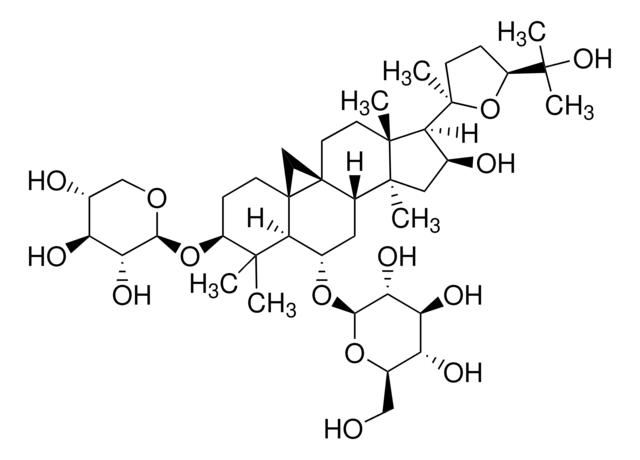SML0723
ML252
≥98% (HPLC)
Synonym(s):
(S)-2-Phenyl-N-(2-(pyrrolidin-1-yl)phenyl)butanamide
Sign Into View Organizational & Contract Pricing
All Photos(1)
About This Item
Empirical Formula (Hill Notation):
C20H24N2O
CAS Number:
Molecular Weight:
308.42
UNSPSC Code:
12352200
NACRES:
NA.77
Recommended Products
assay
≥98% (HPLC)
form
powder
color
, light to dark purple
solubility
DMSO: 25 mg/mL, clear
storage temp.
2-8°C
Biochem/physiol Actions
ML252 is a potent, brain penetrant potassium channel Kv7.2 (KCNQ2) inhibitor with an IC50 of 69 nM. ML252 is only slightly selective over KCNQ3 and KCNQ4 but is over 40-fold selective for KCNQ2 vs KCNQ1, unlike other KCNQ inbhibitors currently used. ML252 was also selective vs. >68 tested GPCRs, ion channels, and transporters. Potassium channel Kv7.2 has become a new target for Alzheimer′s Disease drug research because inhibiting it enhances acetylcholine release. SAR studies showed a small structural change from ethyl group to hydrogen resulted in a functional shift from antagonist to agonist activity (37, EC50 of 170 nM), suggesting an interaction at a critical site for controlling KCNQ2 channel gating.
Storage Class
11 - Combustible Solids
wgk_germany
WGK 3
flash_point_f
Not applicable
flash_point_c
Not applicable
Certificates of Analysis (COA)
Search for Certificates of Analysis (COA) by entering the products Lot/Batch Number. Lot and Batch Numbers can be found on a product’s label following the words ‘Lot’ or ‘Batch’.
Already Own This Product?
Find documentation for the products that you have recently purchased in the Document Library.
Keyong Li et al.
Cell reports, 34(5), 108714-108714 (2021-02-04)
Brainstem networks that control regular tidal breathing depend on excitatory drive, including from tonically active, CO2/H+-sensitive neurons of the retrotrapezoid nucleus (RTN). Here, we examine intrinsic ionic mechanisms underlying the metronomic firing activity characteristic of RTN neurons. In mouse brainstem
Our team of scientists has experience in all areas of research including Life Science, Material Science, Chemical Synthesis, Chromatography, Analytical and many others.
Contact Technical Service








